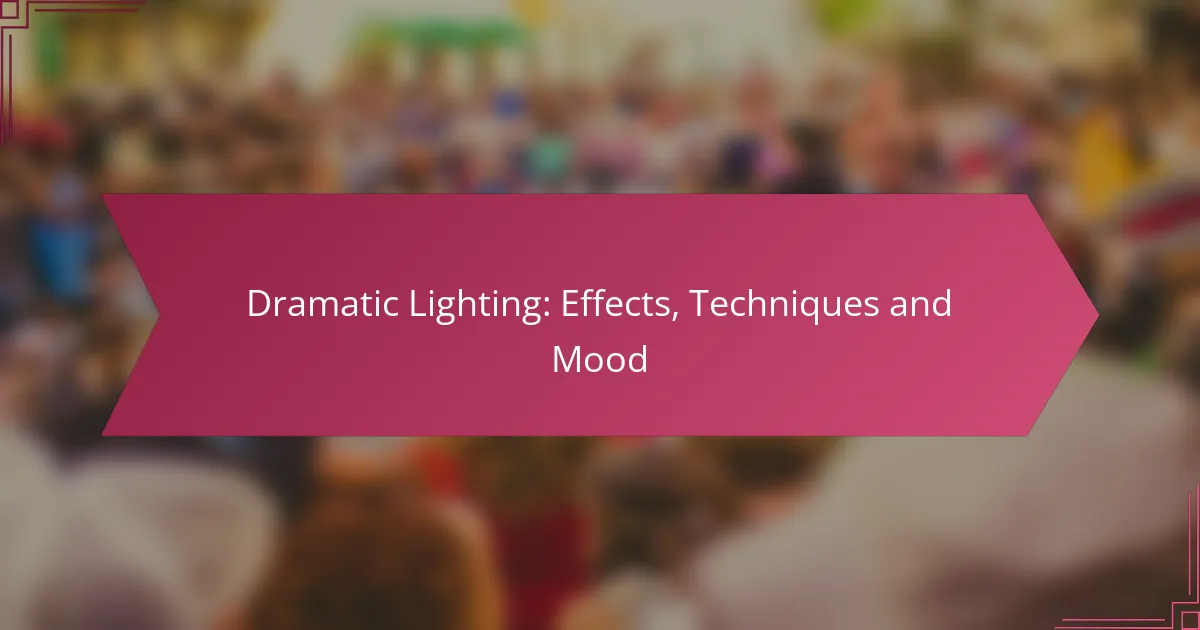Dramatic lighting is a powerful tool in visual storytelling, capable of transforming ordinary scenes into captivating images through striking contrasts and emotional depth. By employing techniques such as chiaroscuro, backlighting, and high-contrast lighting, artists can manipulate shadows and highlights to evoke strong responses from viewers. Understanding the interplay between subject, mood, and environment is essential for selecting the right lighting to enhance the narrative impact of any scene.
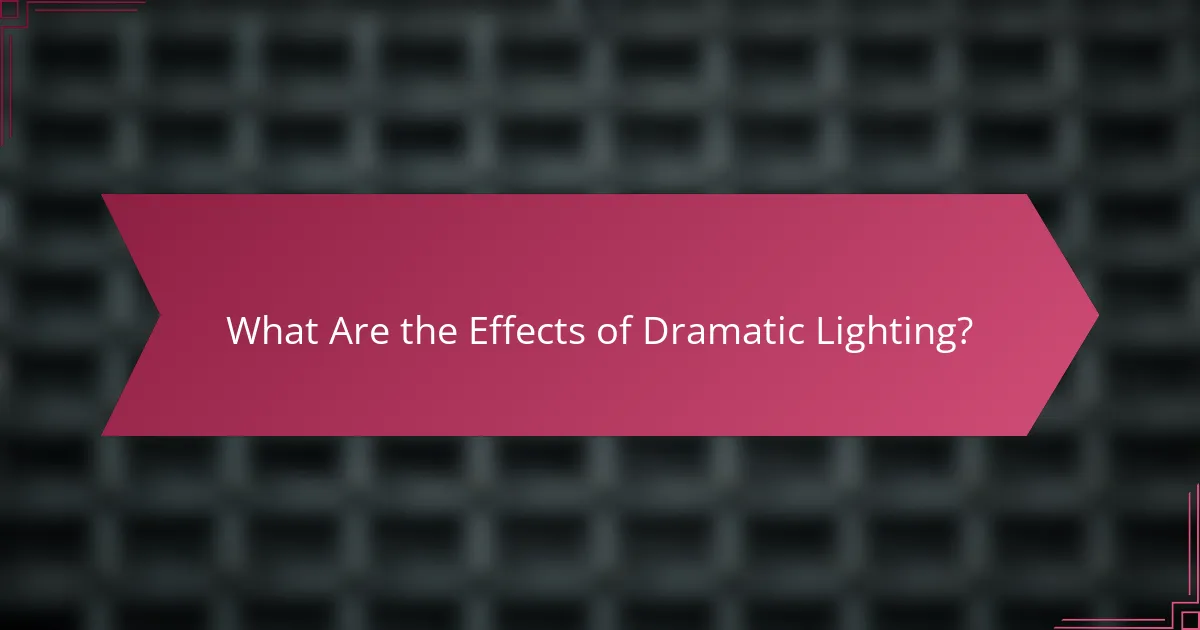
What Are the Effects of Dramatic Lighting?
Dramatic lighting creates striking contrasts and emphasizes specific elements within a scene, significantly impacting the overall visual narrative. It can transform ordinary settings into captivating images by manipulating shadows and highlights to evoke a strong response from the viewer.
Enhances mood
Dramatic lighting is essential for establishing the mood of a scene. By using high contrast between light and shadow, you can create feelings of tension, mystery, or even tranquility. For instance, soft, diffused lighting can evoke calmness, while harsh, directional light can suggest urgency or conflict.
Consider the use of warm tones to create a cozy atmosphere or cooler tones for a more somber effect. Adjusting the intensity and color of the light can dramatically shift the emotional landscape of your composition.
Creates depth
Effective use of dramatic lighting adds a three-dimensional quality to images, making them feel more immersive. By casting shadows and highlights, you can guide the viewer’s eye and create a sense of layering within the scene. This technique helps to separate subjects from the background, enhancing visual interest.
To achieve depth, experiment with backlighting or side lighting, which can accentuate textures and contours. This approach is particularly useful in portrait photography, where it can add dimension to facial features.
Highlights subjects
Dramatic lighting can draw attention to specific subjects within a composition, ensuring they stand out. By strategically placing light sources, you can illuminate key elements while leaving others in shadow, creating a focal point that captures the viewer’s interest.
For example, using a spotlight effect on a performer in a theater can elevate their presence, while dimming the surrounding area enhances their importance. This technique is widely used in both photography and film to guide audience perception.
Sets tone
The tone of a scene is heavily influenced by lighting choices. Dramatic lighting can set a serious, foreboding tone or a lighthearted, whimsical one, depending on how it is applied. The interplay of light and shadow can suggest narrative themes and character emotions.
For instance, low-key lighting often conveys suspense or drama, while high-key lighting can create a cheerful, upbeat atmosphere. Understanding how to manipulate these elements allows creators to effectively communicate their intended message.
Evokes emotions
Lighting has the power to evoke strong emotional responses from viewers. By using dramatic contrasts and color temperatures, you can influence how an audience feels about a scene or subject. Warm lighting might evoke feelings of nostalgia, while cooler tones can induce feelings of sadness or detachment.
To harness this effect, consider the psychological impact of color and light intensity. A well-lit scene can resonate with viewers on a deeper level, making them more engaged with the content. Experiment with different lighting setups to discover how they affect emotional perception.
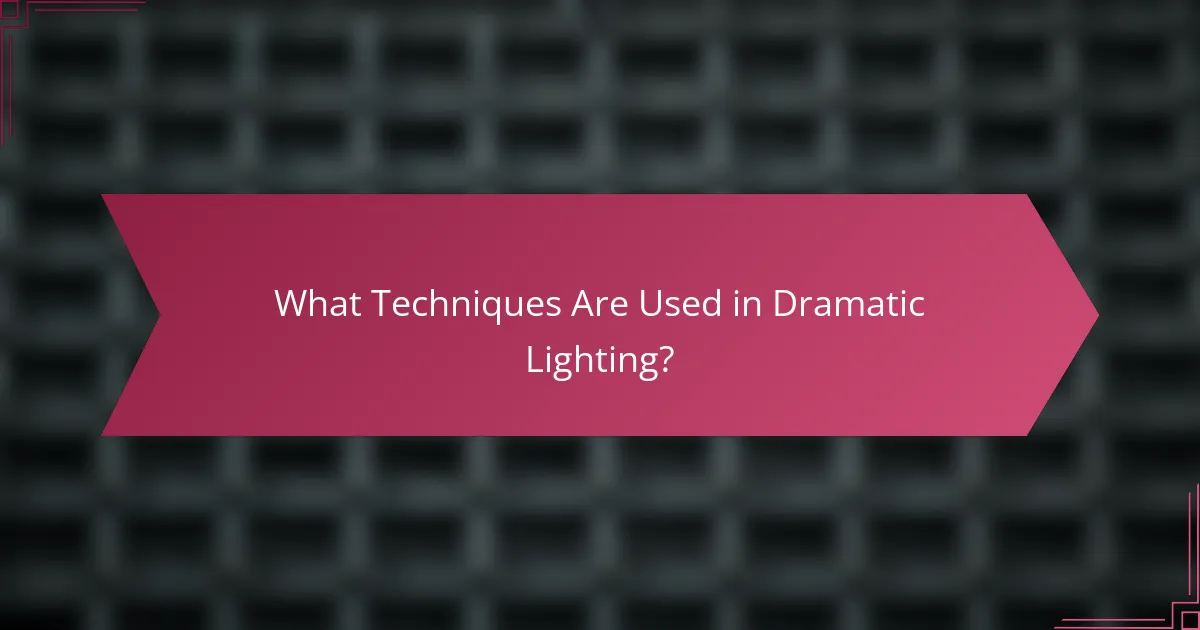
What Techniques Are Used in Dramatic Lighting?
Dramatic lighting techniques enhance visual storytelling by creating strong contrasts and emotional depth. Key methods include chiaroscuro, backlighting, low-key lighting, high-contrast lighting, and the use of color gels, each contributing uniquely to the mood and impact of an image or scene.
Chiaroscuro
Chiaroscuro is a technique that employs strong contrasts between light and dark to create a sense of volume and depth. This method can dramatically highlight subjects while casting others into shadow, enhancing the overall mood. It is commonly used in portrait photography and classical painting to evoke emotion.
To effectively use chiaroscuro, consider the direction of your light source and the placement of your subject. Experiment with different angles and intensities to find the balance that best conveys your desired atmosphere.
Backlighting
Backlighting occurs when the light source is positioned behind the subject, creating a silhouette effect. This technique can add drama and intrigue, emphasizing shapes and outlines rather than details. It works well in nature photography, especially during sunrise or sunset.
When using backlighting, ensure that the subject is well-defined against the light. Adjust exposure settings to prevent overexposure of the background while maintaining some detail in the subject for a more compelling image.
Low-key lighting
Low-key lighting is characterized by a predominance of shadows and minimal light, creating a moody and mysterious atmosphere. This technique is often used in film noir and horror genres to evoke tension and suspense.
To achieve low-key lighting, use a single light source and position it strategically to cast deep shadows. Avoid bright backgrounds and focus on the interplay of light and dark to enhance the emotional impact of your scene.
High-contrast lighting
High-contrast lighting involves using stark differences between light and dark areas to create a striking visual effect. This technique can draw attention to specific elements within a composition and is effective in both photography and cinematography.
To implement high-contrast lighting, use strong light sources and consider the placement of shadows. Be mindful of the overall balance; too much contrast can lead to loss of detail in both highlights and shadows.
Color gels
Color gels are transparent filters placed over light sources to change the color of the light. This technique can dramatically alter the mood of a scene, allowing for creative expression and thematic emphasis. Common colors include blue for cool tones and red for warmth.
When using color gels, consider the color temperature of your light sources and how they interact with the gels. Experiment with different combinations to achieve the desired emotional effect, and be aware of how colors can influence viewer perception and mood.
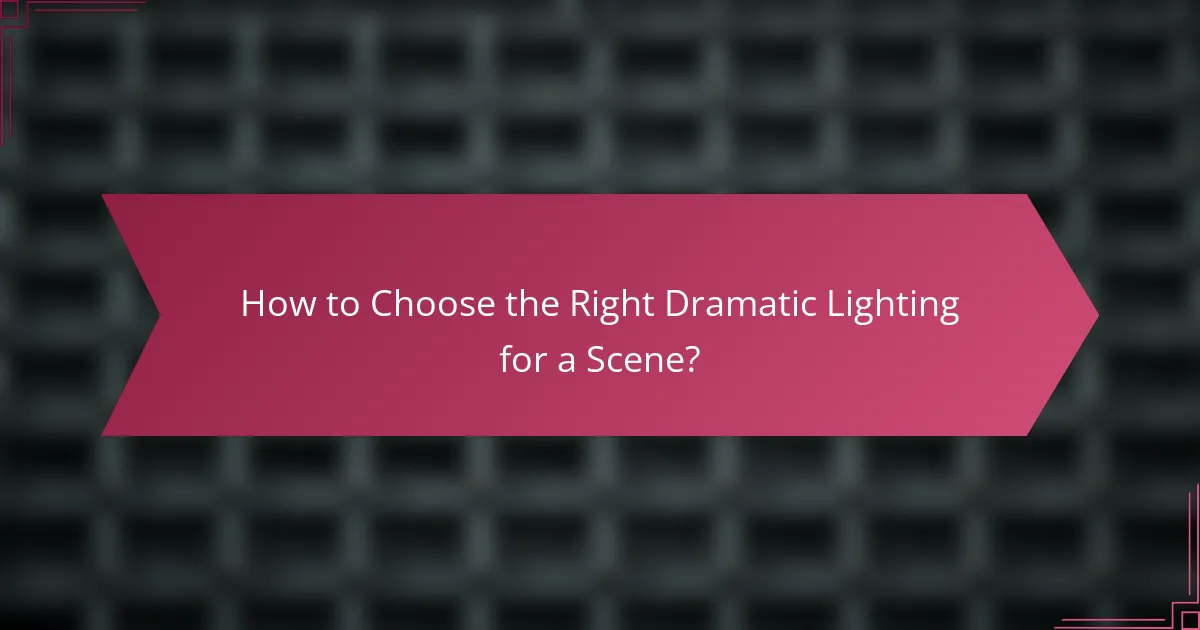
How to Choose the Right Dramatic Lighting for a Scene?
Selecting the right dramatic lighting for a scene involves understanding the subject, mood, environment, and available equipment. Each of these factors plays a crucial role in how the lighting will affect the overall impact of the scene.
Consider the subject
The subject of your scene significantly influences your lighting choices. For instance, a portrait may require soft, diffused light to flatter the subject’s features, while a dramatic landscape might benefit from harsh shadows to emphasize textures.
Evaluate the characteristics of your subject, such as color, shape, and size. A bright subject against a dark background can create striking contrasts, while a darker subject may need more illumination to stand out effectively.
Define the mood
The mood you want to convey is essential in choosing dramatic lighting. Warm, soft lighting can evoke feelings of comfort and intimacy, while stark, high-contrast lighting can create tension or unease.
Consider using color gels or filters to enhance the emotional tone. For example, a blue tint can suggest sadness, while red can evoke passion or anger. Think about how different lighting setups can shift the mood of your scene.
Evaluate the environment
The environment where you are shooting can dictate your lighting options. Natural light may be abundant in outdoor settings, but indoor locations might require artificial lighting to achieve the desired effect.
Take note of reflective surfaces and colors in the environment that can affect how light behaves. For example, a white wall can bounce light and soften shadows, while darker surfaces may absorb light and create harsher contrasts.
Assess available equipment
Your choice of lighting equipment will impact the dramatic effect you can achieve. Consider the types of lights you have access to, such as LED panels, strobes, or continuous lights, and how they can be manipulated.
Familiarize yourself with the capabilities of your gear. For instance, portable lights can be used for on-location shoots, while studio lights may offer more control over intensity and direction. Always have a backup plan in case of equipment failure, such as extra batteries or alternative light sources.
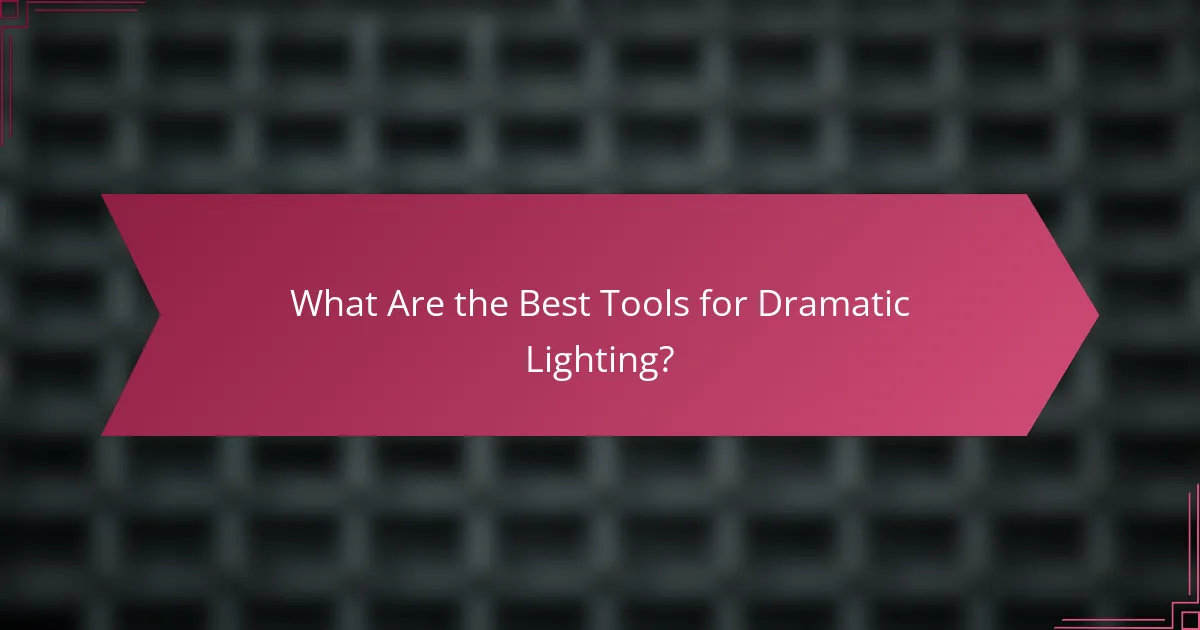
What Are the Best Tools for Dramatic Lighting?
The best tools for dramatic lighting include softboxes, LED lights, reflectors, and diffusers. Each of these tools plays a crucial role in shaping light to create mood and depth in photography or videography.
Softboxes
Softboxes are essential for creating soft, diffused light that reduces harsh shadows. They work by enclosing a light source and using a fabric diffuser to spread the light evenly. This makes them ideal for portrait photography, where flattering skin tones are crucial.
When choosing a softbox, consider the size and shape. Larger softboxes provide softer light, while smaller ones create more contrast. A common size for portraits is around 24×36 inches, but you can adjust based on your shooting environment.
LED lights
LED lights are versatile and energy-efficient, making them popular for dramatic lighting setups. They come in various color temperatures and intensities, allowing for precise control over the mood of your scene. Many models also offer adjustable brightness and color settings.
When selecting LED lights, look for options with a high Color Rendering Index (CRI) for accurate color representation. A CRI above 90 is typically recommended for professional work. Additionally, consider battery-operated models for on-location shoots.
Reflectors
Reflectors are useful for bouncing light and filling in shadows, enhancing the overall lighting effect. They come in various materials and colors, such as silver for a cool tone or gold for warmth. A simple white reflector can also provide a neutral bounce.
To use a reflector effectively, position it opposite your light source at an angle that directs light onto your subject. This technique can dramatically improve the lighting quality without additional equipment. Keep in mind the size of the reflector; larger reflectors cover more area but can be cumbersome to handle.
Diffusers
Diffusers soften and scatter light, reducing harshness and creating a more pleasing effect. They can be used in conjunction with any light source, including natural sunlight or artificial lights. Common materials include fabric, plastic, or even specialized diffusion gels.
When using a diffuser, consider its placement relative to your light source and subject. A good rule of thumb is to position the diffuser about one to two feet away from the light source to achieve optimal softness. Avoid using diffusers in overly bright conditions, as they may not effectively reduce glare.
